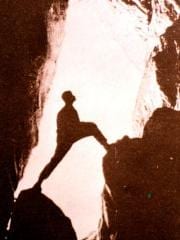Buchenwald
White Lie by Jeanne D'Aout, scene with Otto
“The nightmare was complete when I couldn’t even prove I was a pure blood Aryan, because when I researched my genealogy, I realised my mother and maternal grandfather were Jewish. And I must admit, I was a trouble-maker, I got into fights a lot when I saw SS soldiers misbehave and I wanted to make a career, to move further up the ladder. I was attracted by the power of my superiors, like many others, and in this process I gained a few political enemies. This is how my reputation attracted Hitler’s attention. He demanded my presence at the Berghof, Hitler’s base near Bergtesgaden on the German-Austrian border. I can still remember him, sitting behind his desk, wearing his reading glasses while reading my file. I had never seen him with reading glasses before. While Hitler was reading my file I waited for his reaction. My legs nearly gave way. Then he gave me my new orders, which said that I was drafted to be trained as a soldier, “to make a man out of me”, he said, so I took the journey to Buchenwald…”
Otto started to tremble again.
Otto Rahn y la Búsqueda Nazi por el Secreto de los Cátaros
La Berlin de entreguerras era una ciudad conocida en toda Europa por su sub-cultura bohemia y sus jovenes intelectuales. Entre los personajes que ardientemente celebraban los abundantes «ismos» que estaban fracturando las viejas certezas ideologicas, las cuales habian compactado el siglo XIX, pocos individuos eran mas coloridos que un joven de ojos verdes y cabellos oscuros llamado Otto Rahn. Su figura delgada, envuelta en un caracteristico abrigo negro y sombrero tiroles, arrojaba una larga sombra desde esos anos sombrios, una «gran silueta» alrededor de la cual se han acumulado los mitos mas extravagantes. El fue considerado igualmente como mason, rosacruz, luciferino, y un agente de la Sociedad Thule. Como lo plantea el autor Phillip Kerr, los contemporaneos de Rahn no se habrian sorprendido de ver «la Dama Escarlata y la Gran Bestia salir volando desde la puerta del frente» de su apartamento en Tiergartenstrasse. Uno de sus companeros de la Orden Negra de Heinrich Himmler comento en un memorandum interno que el «medio sospechaba que Rahn tenia relaciones con el pueblo pequeno».
В поисках утраченного Грааля
Берлин между мировыми войнами был городом, известным по всей Европе своей богемной субкультурой молодых интеллектуалов. Среди лиц, которые горячо обсуждали много модернистских "измов", которые ломали старые идеологические определения, что склеивали 19-ое столетие, немногие были более колоритными, чем этот темноволосый, зеленоглазый молодой человек по имени Отто Вильгельм Ран. Его худая фигура, одетая в характерный черный плащ и фетровую шляпу, бросает длинную тень из тех сумеречных лет, ‘великий силуэт’, вокруг которого вращались самые невероятные мифы. Он, как говорили, был Масоном, Розенкрейцером, Люциферианцем, посланцем Общества Туле, посвященным Катаром и даже руководителем некоего неизвестного международного тайного общества.
Otto Rahn im Wikipedia
Otto Wilhelm Rahn (* 18. Februar 1904 in Michelstadt im Odenwald; † 13./14. März 1939 bei Söll (Tirol), Österreich) war ein deutscher Schriftsteller, Mediävist und Ariosoph,[1] der sich mit dem Gralsmythos beschäftigte.
Leben
Schule und Studium
Rahn wurde 1904 in Michelstadt/Odenwald als erstes Kind des Justizamtmanns Karl und Clara Rahn (geb. Hamburger) geboren. Ab 1910 besuchte er das humanistische Gymnasium erst in Bingen, wo er bis zum Beginn des Ersten Weltkriegs lebte. Sein Abitur machte er in Gießen. Dort begeisterte ihn sein Religionslehrer Freiherr von Gall erstmals für die Geschichte der Katharer. 1922 begann Rahn ein Jurastudium in Gießen, das er an der Albert-Ludwigs-Universität Freiburg und der Universität Heidelberg fortsetzte. 1925 bis 1928 unterbrach er sein Jurastudium und betätigte sich als Handelsreisender für verschiedene Verlage.
Отто Ран в Википедии
Отто Вильгельм Ран (нем. Otto Wilhelm Rahn (18 февраля 1904, Михельштадт — 13 или 14 марта 1939, гора Куфштайн близ городка Куфштайн, Тирольские Альпы, Австрия) — немецкий писатель и исследователь, археолог-любитель, сотрудник Аненербе, оберштурмфюрер СС.
Otto Rahn (Dutch)
Otto Rahn werd geboren in Michelstadt (Odenwald) op 18 februari 1904. Na zijn middelbare studies (en de eerste wereldoorlog) trekt hij naar de universiteit waar hij aanvankelijk rechten studeert. Maar al spoedig gaat zijn belangstelling uit naar de literatuur en laat hij zich inschrijven aan de faculteit der letteren in Heidelberg. Zijn droom is literair recensent te worden voor een krant of tijdschrift.
Als muziekliefhebber dweept hij met Wagner. Diens "Parsifal" brengt hem in contact met de graallegenden en hun Duitse auteur Wolfram von Eschenbach. Die studie zal hem nooit meer loslaten.
Otto Rahn Biography
CHRONOLOGY 1904-1939
18 Feb 1904 Otto Rahn born, Michelstadt. Parents Karl & Clara (nee Hamburger)
1910-1916 Junior school at Bigen
1916-21 Secondary school at GrieBen
1922 obtains Baccalaureat
1924 obtains Bachelor in Philology and History
1930 Rahn begins his European travels (Paris, Provence, Switzerland,
Catalonia, Italy)
1931 Rahn visits French Pyrenees. Visits "Spion" in Pyrenees with Himmler and Abetz
1932 Rahn leads a Polaires expedition in Pyrenees
13.12.33 Rahn joins the German Writers Association
1934 publishes "Kreuzzug gegen Gral" (Crusade against the Grail)
1935 appointed to personal staff of Heinrich Himmler
29.2.36 Rahn joins Allgemeine-SS, member 276 208
1936 Rahn visits Iceland with 20 men
1937 publishes "Luzifers Hofgesind. Eine Reise zu denguten Gelstern Europa" (Lucifer's Court in Europe; Rahn sent back to Languedoc (Montsegur), says he will return in 1939. Time of alleged Corbieres visit?
20.4.37 promoted to sub-lieutenant (Untersturmfuhrer)
Sep-Dec1937 military service for "disciplinary reasons" at Oberbayern Regiment, Dachau<
Intervista a Mario Baudino: Otto Rahn, il cacciatore del Graal perduto
Cercava il Graal, trovò il nazismo. Mario Baudino ha ricostruito nel Mito che uccide la storia di Otto Rahn, l'intellettuale tedesco largamente responsabile non solo del moderno successo turistico della Linguadoca, il ”Paese Cataro“, ma soprattutto della mitologia secondo cui i catari, gli antichi eretici del Midi francese, possedevano il Sacro Graal. La vita, breve, di questo misterioso e contraddittorio personaggio, morto suicida nel 1939 poco prima che scoppiasse la Seconda Guerra mondiale, ha lasciato dietro di sé un cumulo di leggende, trasformandolo in un eroe dell'occultismo. La verità storica, raccontata con piglio romanzesco in una ”inchiesta sul passato“ dove nulla è inventato, frutto di attente ricerche in Francia e in Germania, è invece diversa, anche più affascinante. Rahn incarna la figura dell'intellettuale novecentesco che stringe col potere totalitario un patto col diavolo, da cui viene stritolato. E nello stesso tempo è il maggior architetto di una favola destinata a sopravvivergli, ancor oggi molto popolare il tutto il mondo, che associa la mistica coppa cercata dai cavalieri di Artù all'eresia del XII e XIII secolo, ai templari, e infine ai nazisti.
Raiders of the Lost Grail
Berlin between the wars was a city known throughout Europe for its bohemian subculture of young intellectuals. Amongst the personalities who hotly debated the many modernist “isms” that were fracturing the old ideological certainties which had glued together the 19th century, few individuals were more colourful than a dark-haired, green-eyed young man named Otto Wilhelm Rahn. His gaunt figure, swathed in characteristic black coat and fedora, casts a long shadow out of those twilight years, a ‘great silhouette’ around which the most extravagant myths accrued. He was variously said to be a Mason, a Rosicrucian, a Luciferian, an agent of the Thule Gesellschaft, an initiated Cathar and even the leader of an obscure, international secret society. As author Philip Kerr puts it, Rahn’s contemporaries might not have been surprised to see “the Scarlet Woman and the Great Beast come flying out of the front door” of his apartment on Tiergartenstrasse. One of his Nazi peers in Heinrich Himmler’s Black Order remarked in an internal memo that he “half suspected Rahn of being in league with the little people”. To this day, it is widely believed that this enigmatic young man knew the whereabouts of one of the most sacred relics in all Christendom – the Most High Holy Grail. But the truth is stranger still…








Comentarios recientes
hace 13 años 41 semanas
hace 13 años 42 semanas
hace 13 años 42 semanas
hace 13 años 42 semanas
hace 13 años 45 semanas
hace 13 años 51 semanas